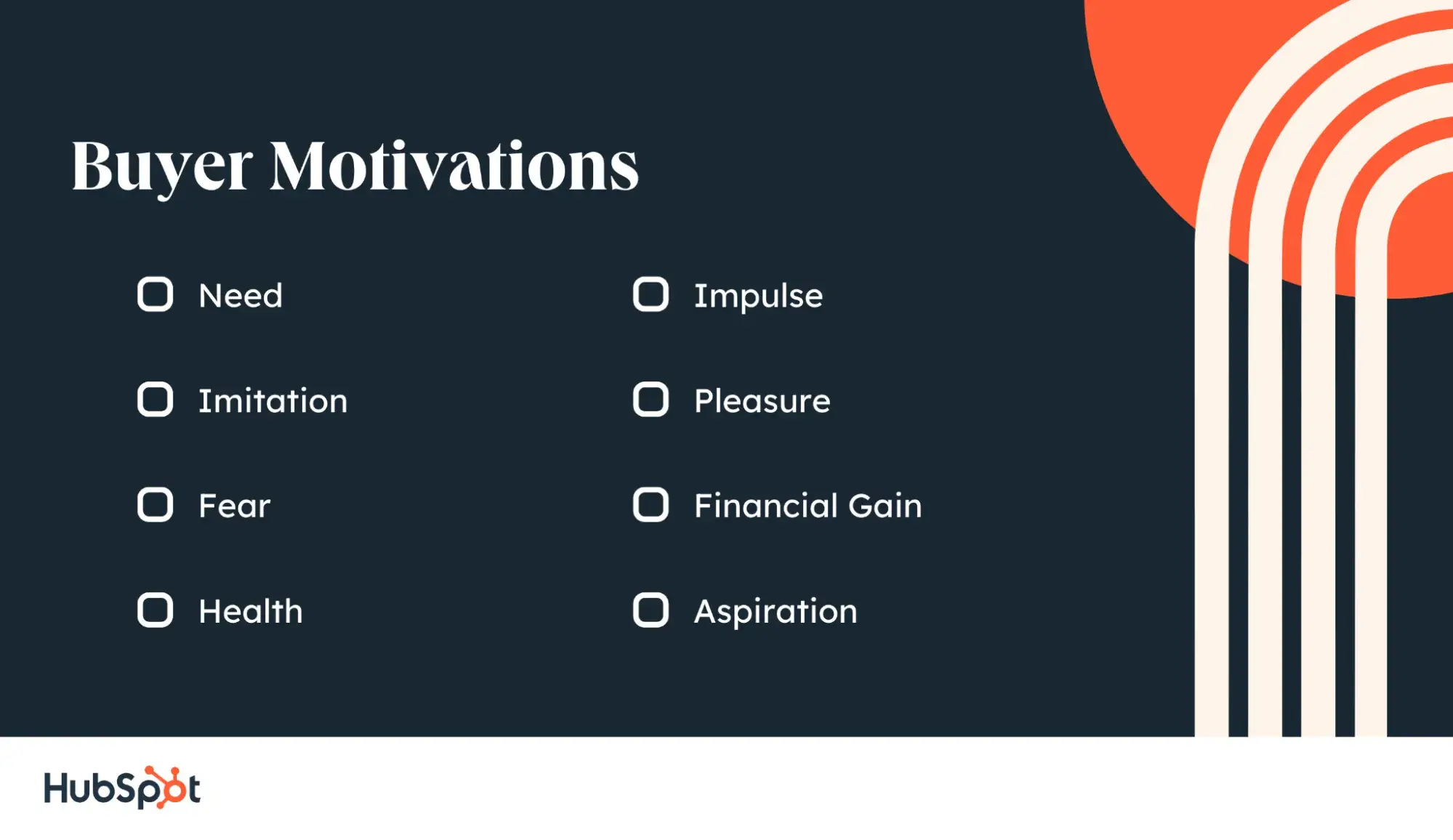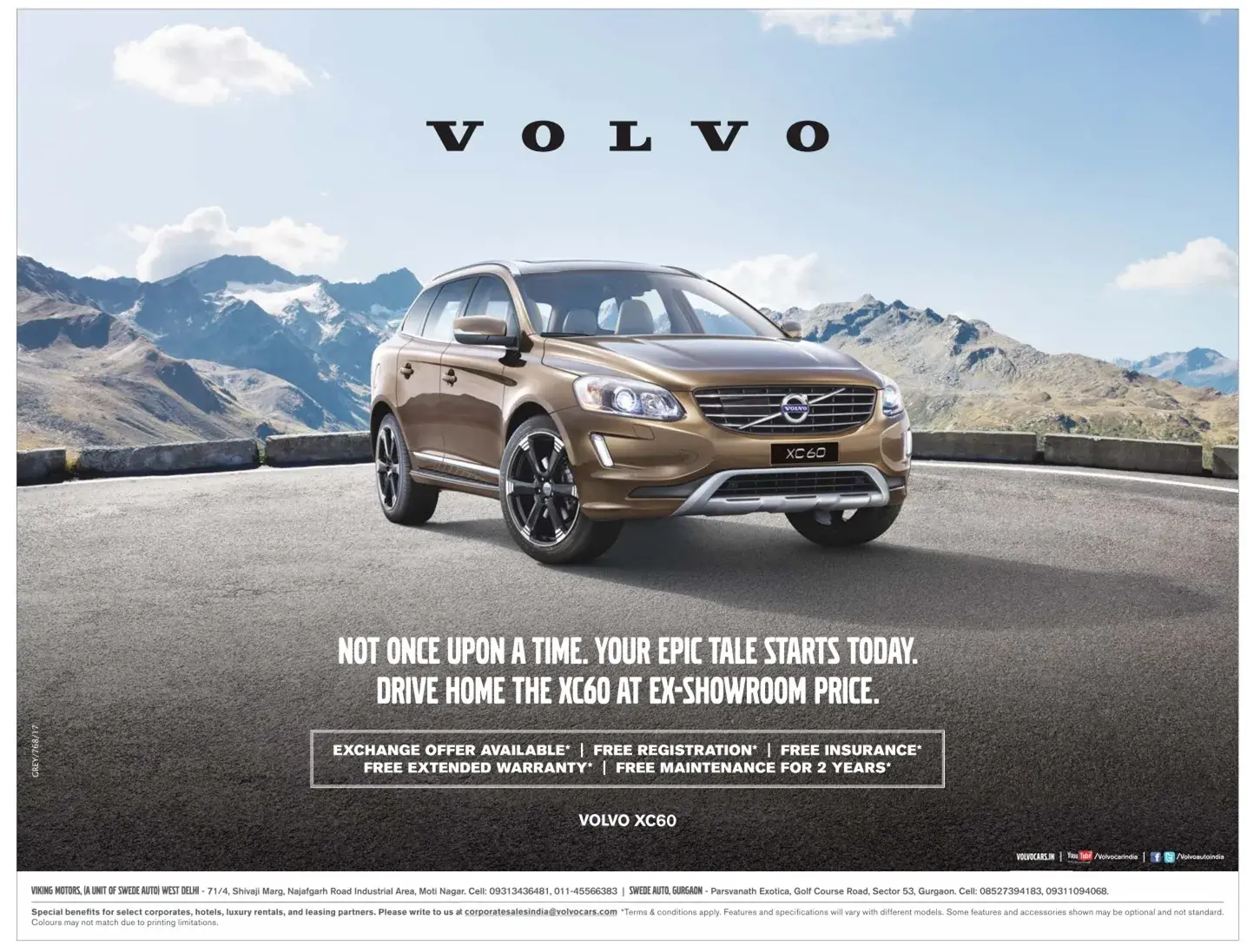Does this sound intriguing? Read on to learn more about the eight buyer motives every salesperson needs to know, as well as my own top tips for how to navigate emotional and rational buyer motivations.
Table of Contents
- Buyer Motivations
- What is buyer motivation?
- Emotional vs. Rational Buying Motivations
- When can rational and emotional buying motives overlap?
What is buyer motivation?
If I’ve learned anything over the course of my marketing and sales career, it’s that people are complicated. The people buying your goods or services are motivated by a complex range of thoughts, feelings, and instincts, and these buyer motivations work together to influence your customers’ purchasing decisions.
It’s also important to note that these diverse buyer motives come into play throughout the customer journey.
The Customer Journey
Specifically, there are three main stages in the customer journey:
- Awareness. When the prospect becomes aware of a need or problem.
- Consideration. When the prospect gathers information about different ways to solve their problem.
- Decision. When the prospect makes a buying decision to solve that problem.
At each stage of this journey, it’s up to you as the salesperson to understand your customer’s motivations. Then, you can use that understanding to effectively communicate the value of your offering, guiding the customer through their journey toward a closed deal.
Pro tip: If you’re not sure where to start, these free Customer Journey Map Templates can help you outline your company’s customer journey and experience from start to finish.
Buyer Motivations
- Need
- Imitation
- Fear
- Health
- Impulse
- Pleasure
- Financial Gain
- Aspiration
Below, I’ll walk through eight of the most common buyer motives to consider, including both emotional and rational motivations.
1. Need
Need might be the most immediate buyer motive. After all, if a prospect has an urgent problem and you can solve it, they’re inherently going to be motivated to consider your offering.
Of course, people aren’t always aware of their needs. You’re more likely to be able to capitalize on your buyer’s needs if they recognize the full spectrum of potential issues that can stem from their situation.
If you approach interactions with prospects assuming that they already have a comprehensive understanding of everything they need, you’re liable to miss out on a lot of opportunities.
Pro tip: Steve Jobs once said, “A lot of times, people don’t know what they want until you show it to them.” The same principle applies to what people need: Prospects don’t always recognize a need until you show them one.
Some buyers will already have a clear-cut picture of their problems and how your product or service could address them … but others might need a little more guidance. As a salesperson, it’s my job to raise my prospect’s awareness of an issue, explain how that issue applies to their situation, and demonstrate how my offering can address it better than anyone else.
2. Imitation
Imitation may be the greatest form of flattery, but it’s also an important buyer motive. When a buyer doesn’t have a direct need for a product, but they’re still motivated to buy it because everyone around them seems to want it, that’s imitation at work.
Pro tip: You may think of peer pressure as exclusive to young people, but research from Washington State University shows that people of all ages are susceptible to FOMO, or “fear of missing out.”
Imitation is the underlying buyer motive that drives many consumer fads. When a certain product or service rapidly becomes popular, people won’t want to miss out on the movement, so they’ll be motivated to buy it out of the desire to imitate those around them.
3. Fear
Beyond fear of missing out, there are many other ways in which fear can serve as a powerful catalyst for action. That’s why so many companies lean on scare tactics — whether subtle or overt — to create urgency behind their messaging and sales efforts.
While this may seem unethical, there are contexts in which speaking to people’s fears can be entirely justified.
For example, the National Highway Traffic Safety Administration recently launched an ad campaign with the slogan “Click It. Don’t Risk It.” to encourage people to buckle up when driving. The campaign emphasizes the very real danger of car crashes, using scary images and statistics to illustrate the importance of wearing a seat belt.
Pro tip: I’ve learned that it’s important to balance leveraging buyers’ reasonable fears with avoiding unethical, manipulative marketing strategies.
As with other motives, buyers may not initially realize that they’re facing a risk that they should be afraid of. While I never recommend stoking fears unnecessarily, effective salespeople can highlight the real downsides of not buying their product or service to raise valid concerns that their prospects may not have recognized otherwise.
4. Health
According to a recent study, health and wellness is the number one driver of Americans’ home-related purchasing decisions. Many consumers prioritize their health above all else — and they’re willing to buy products and services that promise to protect it.
As such, if you can emphasize that your product or service will help people live healthier, longer lives, that can help you capitalize on this important buyer motive.
Of course, you can’t just say that your product will make people healthier. The key to selling based on health is to offer a concrete, legitimate demonstration of the health benefits. Whether it’s a testimonial from a doctor, statistics from a study, or some other form of evidence, you’ll need compelling proof to establish exactly how your product benefits consumers’ well-being.
Pro tip: If you show that your offering addresses a relevant, urgent health concern, you’ll be in an excellent position to sell effectively.
5. Impulse
Take it from me: People don’t always give a ton of thought to the purchases they make. While some decisions are the result of careful deliberation, we all fall under the spell of impulse purchasing now and then.
When consumers get caught up in the heat of the moment and buy for the sake of buying, that’s the result of the impulse buyer motive.
Impulse buying is rooted in excitement. Luckily, as a salesperson, you don’t have to just sit around hoping that your prospects will get excited about your offering — you can take steps to generate that sense of urgency proactively.
Pro tip: Promotional pricing tactics like flash sales or limited-time-only deals can be powerful tools to drive impulse buys.
In addition, I’ve found that imitation and impulse can often go hand in hand. After all, if buyers see their peers embracing a product or service, they might be inclined to jump on the bandwagon without fully considering whether they really need what they’re buying.
6. Pleasure
Some purchases are driven by needs. But, in other cases, people are motivated to buy products or services simply for entertainment or pleasure. These nice-to-have purchases may be less essential, but buyers can still be highly motivated to make them.
After all, we all like to enjoy ourselves. So, from time to time, we all like to buy things just because we want to.
In general, I’ve learned that this buyer motive is most relevant for products or services that are seen as luxuries. Of course, what counts as luxury can be highly subjective, but most of us can at least make a pretty solid guess based on intuition.
Pro tip: To sell to buyers motivated by pleasure, it’s often helpful to cast your product or service as a luxury.
For example, if someone is shopping for home decor or a new pair of designer sandals, their priority is probably pleasure. The same can’t be said for someone looking for insect repellant to deal with their house’s ant problem or for a plumber to deal with a flooded basement.
7. Financial Gain
Especially when it comes to B2B sales, buyers are more willing to spend money if the solution lets them make money. In these cases, the prospect’s main motive is to leverage your product or service to improve their own business operations. For example, they might be looking to purchase a tool that will help them boost employee productivity, generate more revenue, or eliminate unnecessary expenses.
If you’re selling to a prospect with this motive, you should share quantitative metrics that illustrate the results and outcomes you can offer. Remember: Show, don’t tell. I’ve found that referencing similar businesses or current customers that have seen significant financial gains by leveraging your product can be a highly effective strategy for financially motivated prospects.
Pro tip: Put financially-driven buyers at ease by sharing cold, hard facts that illustrate exactly what they can expect if they do business with you.
Prospects motivated by financial gain typically have more at stake than those who are just buying a product to avoid missing out on a hot new trend. That’s why it’s so important to convince them they’ll be in good hands if they invest in your product or service.
8. Aspiration
The last buyer motive that I think is important to consider is aspiration. Some consumers are driven to buy because they aspire to improve themselves. They want to change for the better, and they are willing to spend money to make it happen.
Purchases like gym memberships and subscriptions to online courses, for instance, generally aren’t made out of fear or the pursuit of pleasure. On the contrary, they are motivated by people’s sincere ambition to better themselves.
Pro tip: If you’re selling to a buyer motivated by aspiration, the key is to emphasize what they could achieve — and who they could become — if they opt to make a purchase.
For example, if you’re selling online coursework or paid online certifications, let your prospects know how your product can help bolster their resumes. You can even share testimonials from satisfied customers that highlight how helpful your offering has been for their career development.
At the end of the day, self-improvement requires determination. So, if you want to capitalize on this buyer motive, you’ll need to show your prospects something to be determined about.

Emotional vs. Rational Buying Motivations
Clearly, there are many different kinds of buyer motives. But in general, I’ve found that motivations for buying can be grouped into two main categories: emotional motives and rational motives.
Emotional Buying Motives
When prospects are driven primarily by emotional buying motives, it means that they are motivated to buy something because of how they think the purchase will make them feel. For example, a buyer motivated by the need to feel respected among their peers would be considered emotionally motivated.
Pro tip: To sell to emotionally-motivated buyers, it can be helpful to focus on the emotional benefits of your product or service.
In my experience, emotional marketing tactics such as telling a compelling story and creating a sense of community can be great ways to engage with more emotionally-motivated buyers.
Rational Buying Motives
In contrast, rational buying motives are driven by logic and reasoning. What are examples of rational buying motives? These buyers are likely to consider factors such as durability, safety, and price before making a buying decision.
Pro tip: Rationally-motivated buyers are more likely to be convinced by quantitative facts and evidence than by a more emotional sales pitch.
There are a wide range of sales tactics that can be effective when selling to more rationally-driven buyers, from doing extensive research to understand the prospect’s needs to quantifying the benefits of your offering in terms of time or dollars saved.
Example: Two Kinds of Car Buyers

To illustrate the differences between emotional and rational buying motives, it’s helpful to consider a pair of examples. So, let’s imagine a consumer looking to purchase a car.
A Rational Buyer Example
If the consumer is rationally-motivated, the process might look something like this: They first spend time conducting extensive research on factors like fuel economy, safety, and durability.
Then, they identify a specific used vehicle at a local dealership that meets their ideal specs and budget, and despite its lack of fun features like power windows or a stereo, they buy the car. This purchase is based on concrete need and practical utility, making it a highly rational purchase.
An Emotional Buyer Example
In contrast, an emotionally-motivated purchase might look more like this: A consumer already owns a car, but stops by the local dealership to check out a new line of convertibles. They didn’t plan to buy anything, but they saw a car that they immediately decided was the car of their dreams.
They take it for a test drive, and they love how it rides. They imagine how cool they would look driving along the Pacific Coast Highway with the top down, wearing a scarf, aviator sunglasses, and leather gloves. They get so excited that they buy the car on the spot.
Most purchases fall somewhere between these extremes — but these examples capture the essence of the two categories: Emotional motivations include feelings such as pleasure, vanity, comfort, or prestige, while rational motivations tend to be based on factors like budget, safety, and durability.
When can rational and emotional buying motives overlap?
In my experience, it’s rare for a buyer to be 100% rational or 100% emotional. Instead, real-world buying decisions are most often a combination of both.
As sales expert Sander van Dongen explains, “Rather than viewing emotions and logic as opposing forces, it’s more accurate to consider them as complementary elements that together form a powerful combination in consumer decision-making.”
He argues that “emotions create the initial desire to buy, while logic provides the necessary justification to validate the purchase.” As such, van Dongen suggests that “effective marketing strategies harness both these elements.”
Of course, this can be a tricky tension to navigate as a salesperson or business owner. Restaurant Manager at Deschutes Brewery Ryan McCargo recognizes this challenge in his own work, reflecting that “the balance between rational and emotional approaches within a marketing campaign can be daunting.”
According to McCargo, being rational is best when you want to illustrate the usability and functionality of the campaign.
“When you’re ready to communicate the campaign's purpose and connect it to its place within the wide world, that is when to clutch your emotional pearls,” McCargo says.
McCargo notes that people like to see rationality when asking, “What makes this product good/quality?.” They need emotional connection to pull the trigger on the question, “Why is this product good for me?”
At the end of the day, we are all only human — and humans are naturally both emotional and rational. Rather than attempting to classify every prospect as motivated exclusively by just one factor, I’ve learned that effective salespeople embrace the nuance and complexity of their customers’ diverse motivations.
Understand Buyer Motives to Increase Sales
Whenever I talk to prospects, my first question is always, “Why?” Why is this person interested in what I have to offer? What drives them? What are they afraid of, or what are they hoping for?
If you take the time to understand why your prospects are considering buying from you, you’ll be empowered to craft a sales approach that’s tailored to their unique buying motives.
Ultimately, understanding your buyers’ motives can help you create campaigns that engage your prospects and nudge them toward buying your product or service. After all, there’s a reason for every purchase. It’s up to you to identify it.


.webp)

![B2B Sales Experience: 12 Best Ways to Delight Prospects [Examples]](https://53.fs1.hubspotusercontent-na1.net/hubfs/53/b2b-sales-experience-1-20250516-6151471.webp)


![What is the Buyer’s Journey? [+ My Tips for Applying it to Your Sales Cycle]](https://53.fs1.hubspotusercontent-na1.net/hubfs/53/copy%20of%20jade%20walters%20btb%20(25).png)
